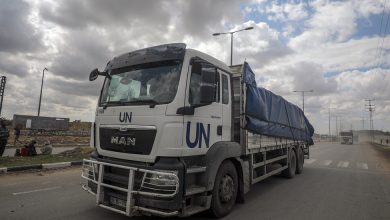Climate Change Is Harming the Planet Faster Than We Can Adapt, U.N. Warns

The dangers of climate change are mounting so rapidly that they could soon overwhelm the ability of both nature and humanity to adapt unless greenhouse gas emissions are quickly reduced, according to a major new scientific report released on Monday.
The report by the Intergovernmental Panel on Climate Change, a body of experts convened by the United Nations, is the most detailed look yet at the threats posed by global warming. It concludes that nations aren’t doing nearly enough to protect cities, farms and coastlines from the hazards that climate change has unleashed so far — such as record droughts and rising seas — let alone from the even greater disasters in store as the planet continues to warm.
Written by 270 researchers from 67 countries, the report is “an atlas of human suffering and a damning indictment of failed climate leadership,” said António Guterres, the United Nations secretary general. “With fact upon fact, this report reveals how people and the planet are getting clobbered by climate change.”
The perils are already visible across the globe, the report said. In 2019, storms, floods and other extreme weather events displaced more than 13 million people across Asia and Africa. Rising heat and drought are killing crops and trees, putting millions worldwide at increased risk of hunger and malnutrition, while mosquitoes carrying diseases like malaria and dengue are spreading into new areas. Roughly half the world’s population currently faces severe water scarcity at least part of the year.
Few nations are escaping unscathed. Blistering heat waves made worse by global warming have killed hundreds of people in the United States and Canada, ferocious floods have devastated Germany and China, and wildfires have raged out of control in Australia and Siberia.
“One of the most striking conclusions in our report is that we’re seeing adverse impacts that are much more widespread and much more negative than expected,” said Camille Parmesan, an ecologist at the University of Texas, Austin, and one of the researchers who prepared the report.
To date, many nations have been able to partly limit the damage by spending billions of dollars each year on adaptation measures like flood barriers, air-conditioning or early-warning systems for tropical cyclones.
But those efforts are too often “incremental,” the report said. Preparing for future threats, like dwindling freshwater supplies or irreversible ecosystem damage, will require “transformational” changes that involve rethinking how people build homes, grow food, produce energy and protect nature.
The report also carries a stark warning: If temperatures keep rising, many parts of the world could soon face limits in how much they can adapt to a changing environment. If nations don’t act quickly to slash fossil fuel emissions and halt global warming, more and more people will suffer unavoidable loss or be forced to flee their homes, creating dislocation on a global scale.
“There has been the assumption that, ‘Well, if we cannot control climate change, we’ll just let it go and adapt to it,’” said Hans-Otto Pörtner, a marine biologist in Germany who helped coordinate the report. But given the expected risks as the planet keeps warming, he said, “this is certainly a very illusionary approach.”
Global temperatures have already increased by an average of 1.1 degrees Celsius, or 2 degrees Fahrenheit, since the 19th century, as humans have pumped heat-trapping gases into the atmosphere by burning coal, oil and gas for energy, and cutting down forests.
Many leaders, including President Biden, have vowed to limit total global warming to no more than 1.5 degrees Celsius compared with preindustrial levels. That’s the threshold beyond which scientists say the likelihood of catastrophic climate impacts increases significantly.
But achieving that goal would require nations to all but eliminate their fossil-fuel emissions by 2050, and most are far off-track. The world is currently on pace to warm somewhere between 2 degrees and 3 degrees Celsius this century, experts have estimated.
“Unchecked carbon pollution is forcing the world’s most vulnerable on a frog march to destruction — now,” Mr. Guterres said. “This abdication of leadership is criminal.”
If average warming passes 1.5 degrees Celsius, even humanity’s best efforts to adapt could falter, the report warns. The cost of defending coastal communities against rising seas could exceed what many nations can afford. In some regions, including parts of North America, livestock and outdoor workers could face rising levels of heat stress that make farming increasingly difficult, said Rachel Bezner Kerr, an agricultural expert at Cornell University who contributed to the report.
“Beyond 1.5, we’re not going to manage on a lot of fronts,” said Maarten van Aalst, the director of the Red Cross Red Crescent Climate Center and another author of the report. “If we don’t implement changes now in terms of how we deal with physical infrastructure, but also how we organize our societies, it’s going to be bad.”
Poor nations are far more exposed to climate risks than rich countries. Between 2010 and 2020, droughts, floods and storms killed 15 times as many people in highly vulnerable countries, including those in Africa and Asia, than in the wealthiest countries, the report said.
That disparity has fueled a contentious debate: what the industrialized nations most responsible for greenhouse gas emissions owe developing countries. Low-income nations want financial help, both to defend against future threats and to compensate for damages they can’t avoid. The issue willbe a focus when governments meet for the next United Nations climate summit in Egypt in November.
“Climate change is the ultimate injustice,” said Ani Dasgupta, the president of the World Resources Institute, an environmental group. “People with the fewest resources, those least responsible for the climate crisis, bear the brunt of climate impacts.” He added, “If you don’t live in a hot spot, imagine instead a roof blown away, a village well overwhelmed by salt water, a failed crop, a job lost, a meal skipped — all at once, again and again.”
The report, which was approved by 195 governments, makes clear that risks to humans and nature accelerate with every additional fraction of a degree of warming.
At current levels of warming, for example, humanity’s ability to feed itself is already coming under strain. While the world is still producing more food each year, thanks to improvements in farming and crop technology, climate change has begun slowing the rate of growth, the report said, an ominous trend that puts future food supplies at risk as the world’s population soars past 8 billion people.
If global warming reaches 1.5 degrees Celsius — as is now likely within the next few decades — roughly 8 percent of the world’s farmland could become unsuitable for growing food, the authors wrote. Coral reefs, which buffer coastlines against storms and sustain fisheries for millions of people, will face more frequent bleaching from ocean heat waves and decline by 70 to 90 percent. The number of people around the world exposed to severe coastal flooding could increase by more than one-fifth without new protections.
At 2 degrees Celsius of warming, between 800 million and 3 billion people globally could face chronic water scarcity because of drought, including more than one-third of the population in southern Europe. Crop yields and fish harvests in many places could start declining. An additional 1.4 million children in Africa could face severe malnutrition, stunting their growth.
Understand the Latest News on Climate Change
A world on fire. A United Nations report has concluded that the risk of devastating wildfires around the world could increase by up to 57 percent by the end of the century, as climate change further intensifies what the authors of the document described as a “global wildfire crisis.”
Melting away. Sea ice around Antarctica has reached a record low in four decades of observations, a new analysis of satellite images shows. While warmer ocean temperatures may have played a role, the precise effect of climate change on Antarctic sea ice remains unclear.
A megadrought and rising sea levels. An intense drought in the American Southwest has become so severe that it’s now the driest 22-year period in the region in 1,200 years. Scientists are also warning that coastal sea levels in the U.S. will rise by about a foot or more on average by 2050.
Depleting water supplies. The world’s glaciers may contain less water than previously believed, suggesting that freshwater supplies could peak sooner than anticipated for millions of people worldwide who depend on glacial melt for drinking water, crop irrigation and everyday use.
At 3 degrees of warming, the risk of extreme weather events could increase fivefold by century’s end. Flooding from sea-level rise and heavier rainstorms could cause four times as much economic damage worldwide as they do today. As many as 29 percent of known plant and animal species on land could face a high risk of extinction.
The report lays out strategies that nations can pursue to protect themselves, such as elevating homes above rising floodwaters or developing new crop varieties that can better tolerate heat and drought.
Humanity has already managed to reduce some of the harms from climate dangers. Over the past half-century, the number of deaths worldwide from storms, floods and other extreme weather events has fallen by more than half because of improved early warning systems and disaster management, the World Meteorological Organization has found. Investments in public health have meant fewer people are succumbing to diseases like cholera, even as rising temperatures and heavier rainfall have facilitated their spread.
But if global temperatures keep rising, adapting to climate change will become increasingly difficult, especially for poorer countries, the report said.
“If we are able to limit warming to 1.5 degrees, then the likelihood of large areas or specific islands becoming uninhabitable will be relatively low,” although they will remain vulnerable to storms and sea-level rise, said Adelle Thomas, an adaptation researcher at the University of the Bahamas and a report author. But higher levels of warming “could lead to those areas becoming uninhabitable,” she said.
A decade ago, wealthy nations pledged to deliver $100 billion per year to the developing world by 2020 to shift to cleaner sources of energy and adapt to climate change. But they have fallen short by tens of billions of dollars, with only a fraction of the funds spent on adaptation.
Meanwhile, many communities are acting in ways that increase their vulnerability, the report said. One reason flood risk is growing along the coasts, for instance, is that millions of people are moving to low-lying areas that are endangered by sea level rise. And some adaptation measures have unintended consequences. For instance, sea walls protect certain places but can also redirect flooding into populated areas elsewhere. Irrigation can help protect crops against drought but can also deplete groundwater resources.
“Despite the fact that we have been talking about climate change for a long period of time,” many regions are still developing in ways that make their people and ecosystems more exposed to the hazards, not less, said Ibidun O. Adelekan, a professor of geography at the University of Ibadan in Nigeria who worked on the report.
Instead, the report recommends that leaders pursue more farsighted strategies. As oceans rise, coastal communities could relocate inland while additional development along vulnerable shorelines could be discouraged. Improvements in basic services like health, roads, electricity and water could help make poor and rural communities more resilient against climate shocks.
“The choice is not between if we transform or not anymore,” said Edward R. Carr, a professor of international development at Clark University and an author of the report. “The choice is, do we choose transformations we like? Or do we get transformed by the world in which we live because of what we’ve done to it?”
The report is part of the sixth major assessment of climate science from the Intergovernmental Panel on Climate Change, which was created in 1988. The first report in the series, released last August, examined the science behind how human activity is heating the planet. A separate report, expected this spring, will explore strategies to reduce greenhouse gas emissions and halt warming.





